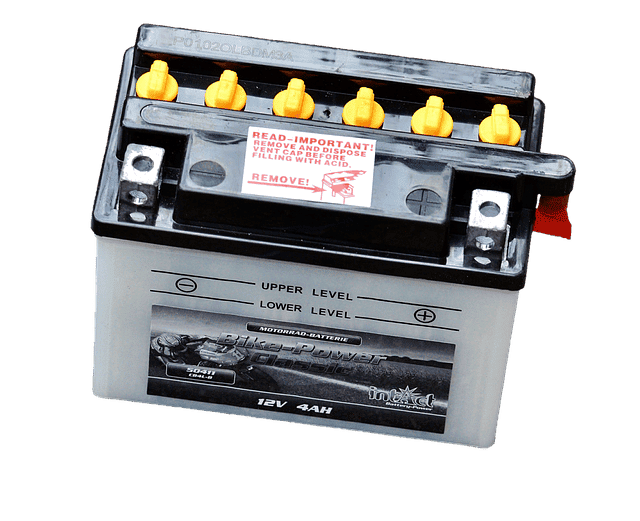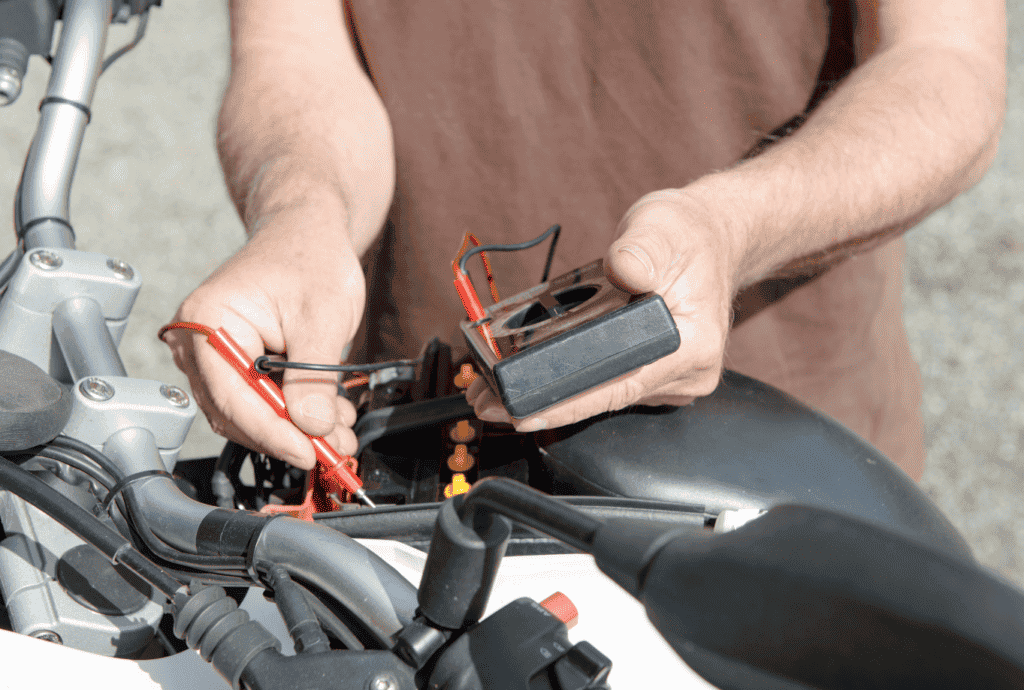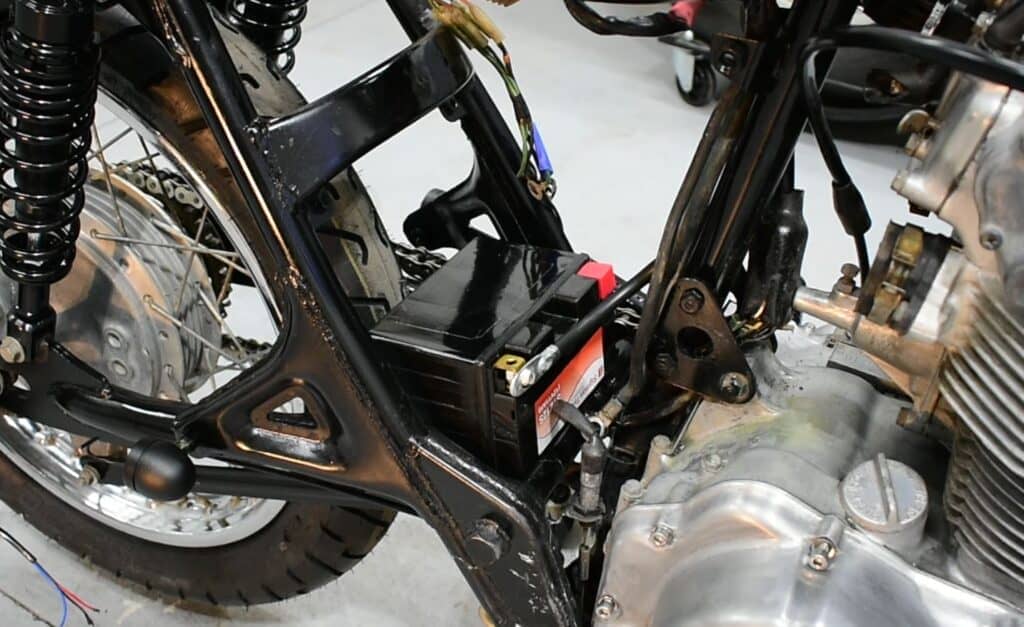
Often times, a lot of us are not able to ride our motorcycles as frequently as we’d like. I’ve been guilty of letting my motorcycle sit for months at a time. I wondered how long a motorcycle can sit before the battery dies, so I did some research and some personal trial and error to find out.
So how long can a motorcycle sit before the battery dies? The average motorcycle battery will die after 2 – 4 months without running. Newer batteries can last longer with an average of 3 – 5 months until dying whereas older batteries will not last as long, giving it an average of 1 – 3 months until the battery dies while the motorcycle is sitting.
There is a lot to consider when it comes to letting your motorcycle sit and it’s battery life. Dead batteries tend to happen at the least convenient times. This article will help you understand how the whole system works and provide some maintenance tips. That way you can be sure that you won’t be left stranded with a dead motorcycle battery.
Why a Motorcycle Battery Loses Power When It’s Not Used
It’s important to use your motorcycle periodically to keep the battery in check. If a motorcycle battery is not used and just sits, it will lose it’s capacity to power your motorcycle. Every time you let your battery die, it causes some permanent damage, making your battery lose some of it’s ability to charge fully.
Think of it this way: if you’ve ever broken a bone, you understand what it’s like having a cast and not being able to use that part of your body. When you finally get your cast off, you’ve temporarily lost the ability to use that body part to it’s full capacity because you haven’t been using it or exercising your muscles. A motorcycle battery is similar.
There is also a phenomenon called parasitic drain. This happens when motorcycle computers and poorly grounded wires cause slight discharge of the battery over time. In other words, your battery may lose charge as it slowly gets drained from some other unwanted source.
This phenomenon is especially common with older bikes. Each time you don’t use your motorcycle, this parasitic drain can cause further damage. A good rule of thumb that one of my automotive professors taught me was that batteries have 9 lives just like cats. Each time you let the battery fully discharge it loses some of it’s full charging potential.
Cold weather doesn’t necessarily drain your battery, it just means your motorcycle requires more voltage to start which your battery might not be able to give.
When a connection is made between the positive and negative terminals of the battery, an electric current is generated. A chemical reaction is then created that enforces the electrons to produce the current of the battery. Cold temperatures hinder this chemical reaction which causes less current produced.
Letting a motorcycle battery sit dormant in cold weather will cause problems with starting. The cold ambient air restrains the battery from producing enough current to even start the motorcycle at all. Keeping a motorcycle outside in the elements can make the battery especially susceptible to this. See my article here to learn more about the other things that happen to your motorcycle when you let it sit.
How to Keep a Motorcycle Battery Charged

Most motorcycles require a 12 volt battery. To get a bit technical, the exact voltage is 12.6. 12.6 volts is considered a 100% charged battery, 12.4 volts is considered 75% charged, and 12.2 volts is considered 50% charged.
In order to start a motorcycle, you need at least 12.2 volts, or a 50% charge on a new battery. As a battery gets older, it loses efficiency and a higher battery percentage is necessary to start the bike. A rule of thumb to remember, just because your battery is at 12.6 volts does not mean it will start your bike, having enough current is what starts the motorcycle. Checking the voltage is just a good indicator.
Once you start your motorcycle, the battery gets charged back up by your stator, which outputs about 15V. Almost all motorcycles have a stator, some small dirt bikes do not. You can tell if your motorcycle does not have a stator by looking at the headlight while it is running. If you rev the bike and the headlight gets much brighter, then you most likely do not have a stator. If it stays the same brightness then you do have a stator.
A cautious motorcyclist will take good care of their motorcycle, especially the battery. Motorcycle batteries are a frequent culprit when it comes to motorcycle problems. There are several ways to keep a charge on your battery that can save you a lot of future head aches.
Make sure you know how old your battery is. A good healthy battery life is about 48 months, or about 4 years. If you know your battery is getting close to that age, be aware that it may give out some time soon and don’t be surprised if your motorcycle doesn’t start. Also make sure to take note of the size of your battery when you eventually have to get a new one.
Try using a battery charger. One type of battery charger you can use is called a battery trickle charger. A trickle charger provides a constant charge to your battery. You need to be careful with these chargers though because you can cause permanent damage to your battery if you keep these on too long. These are usually the cheapest type of chargers because they don’t have any built in protections.
You can also try using a battery tender. This type of battery charger is one that I use and highly recommend. It has a sensor that indicates when your charge is too low and needs to start charging, or senses your battery is fully charged and will stop supplying a charge. You can keep this charger connected to your battery for any amount of time, worry-free.
If you live in a cold climate, you’ve probably experienced too many dead batteries on your motorcycle. Try to keep your motorcycle inside a garage or shed if possible. Properly winterizing your motorcycle is vital to it’s battery health.
If it’s still too cold and your motorcycle won’t start, use a space heater to pre-heat your engine by placing it directly next to your motorcycle. Don’t put it too close and burn something! Click here to see my article that discusses what happens when a motorcycle battery freezes.
Once your motorcycle is warmed up, you should have an easier time starting it. I have used this method dozens of times and has proven to be a sure way to get a motorcycle started when it’s cold.
Having a multimeter handy is almost essential. A multimeter is an electronic measuring instrument. It can measure things such as voltage, current, and resistance and I use this tool frequently to understand where the life of my battery is at.
How to Make Sure You Have the Right Size of Battery for your Motorcycle

It is important that you have the right size of battery for your motorcycle. If you don’t have the right size, you can cause some damage to the battery and to your motorcycle.
If you use a higher voltage battery than intended, like accidentally using an 18V, you run the risk of burning wires on your motorcycle (and trust me, that is a NIGHTMARE to fix). If you use too little of a battery you’ll never get the bike on the road.
If you have your user’s manual, that should tell you what size of battery you need. If not, there are thousands of PDF files online that will be able to steer you in the right direction. In order to buy the correct battery, you need to know the necessary CCA (Cold Cranking Amps), voltage (some older bikes use 6V batteries), and the correct dimensions so it will fit in the battery tray.
You can also consult with a motorcycle shop if you’re having a hard time finding the correct battery online. Often times if you tell them the make and model of your motorcycle over the phone they can tell you what kind of battery you need. Just be sure to get the right size.
How a Motorcycle Battery Works
There are two types of batteries used on motorcycles. The first is the lithium ion phosphate battery, the second is the classic lead acid battery, which is the most commonly used battery.
Most people assume batteries are a storage unit of electricity, when in reality they convert chemical energy into electrical energy.
Inside the battery there are several cells with plates inside of them. A 12 volt battery has six cells that produce just over 2 volts each. All of this is submerged in an acid mixture (in a lead acid battery). A series of chemical reactions are made and a current is created which ultimately gives you the charge you need to start your motorcycle.
It’s important to remember to not use flames around motorcycle batteries as they can emit flammable gases. Also be cautious of the acid inside of the battery. It can be harmful to your clothes, objects, and especially your skin.
Related Questions
Can I use a car charger to charge my motorcycle battery? Though it is not recommended, you can use a car charger to charge your motorcycle battery. Be cautious of this though, car battery chargers charge at a higher amperage and can quickly damage a motorcycle battery. Be sure to supervise the charge and adjust the current settings of the car charger.
Does a motorcycle have an alternator? Some motorcycles have an alternator while others have a generator/magneto/stator. All of these provide the same function of charging the motorcycle battery while the motorcycle is running.
